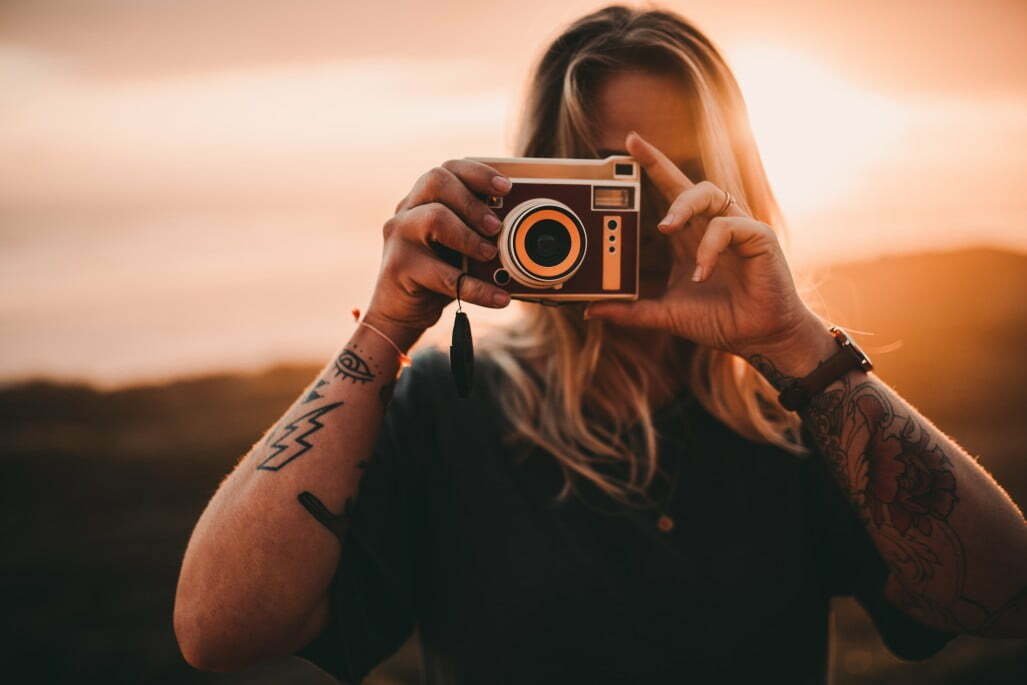If you are shopping around for a new camera, you may be comparing flip cameras vs digital cameras. Some of the best digital cameras, after all, can be available in either form factor. Keep reading to learn more about the differences between flip cameras and digital cameras.
KEY TAKEAWAYS:
- Flip cameras are essentially digital cameras with a moveable or flip-up screen.
- Flip screens are great for framing shots around obstacles and for making sure the viewfinder is not obstructed by microphones and cables.
- Flip screens are also great for vlogging, as it allows performers to keep an eye on the viewfinder to ensure they are in the frame.
Differences Between Flip Cameras and Digital Cameras
Generally speaking, flip cameras are digital cameras. The main difference is the optical viewfinder. Flip cameras feature a flip-up screen to conserve space while traditional digital cameras feature a static fixed-position screen. They both have many features in common to create sharp images, including optical zoom, decent dynamic range, digital zoom, autofocus, and built-in image stabilization. In other words, the differences between the two are not as stark as when comparing a DSLR camera vs a compact digital camera.
Here are some use case scenarios in which a flip camera would come in handy over a regular digital camera.
Insider Tip
Adjust a flip screen carefully, so you will not accidentally cause damage.
Framing
The main reason a consumer would choose flip screens over a traditional camera is that the former allows for an easier way to frame difficult shots. Why? You can flip the screen to a number of different positions to get it out of the way of microphones, various cables, and obstacles. This gives you a good view of your subject no matter where you are placed as the photographer and where they are located. You can also adjust the location of the screen to avoid sunlight and glare. When it comes to framing, you may want to consider a full-frame digital camera vs APS-C.
Space Preservation
Flip screens can be positioned to conserve space, giving the camera a more compact form factor than a regular digicam. This can be useful when it comes to packing and fitting the camera into a storage case. If you are lugging around a lot of photography equipment, any space you can space in your travel pack is appreciated. Additionally, the moveable nature of a flip screen gives slightly increased durability, as you can press it against the body of the camera.
Vlogging
Flip cameras are often used for selfies and for making quick video vlogs. This is due to the moveable nature of the screen. You can easily adjust the optical viewfinder so that it is facing the front, so you can keep an eye on it as you record, ensuring that you are always properly in the frame.
F.A.Q.S
What essential gear do I need for vlogging?
A camera with a flip screen will be useful, as with a. dedicated microphone, a tripod, and a gimbal.
How to edit an impactful vlog?
This depends on your intent, but try to make sure you have enough B roll so you can take many different approaches to the material.
What is the purpose of an LCD screen on a camera?
Cameras with an LCD screen, such as the Canon EOS series and other mirrorless cameras, allow you to see what is going on as you record or take photos. This leads to increased video recording capability and great shots for selfie cameras.
STAT: The Flip Ultra was the best-selling camcorder on Amazon.com after its debut, capturing about 13% of the camcorder market. (source)
REFERENCES:



































![Best Point and Shoot Camera in [year] ([month] Reviews) 27 Best Point and Shoot Camera in 2026 (January Reviews)](https://www.gadgetreview.dev/wp-content/uploads/Nikon-Coolpix-B500.jpg)
![Best Underwater Camera in [year] ([month] Reviews) 28 Best Underwater Camera in 2026 (January Reviews)](https://www.gadgetreview.dev/wp-content/uploads/best-underwater-camera-image.jpg)
![Best Digital Cameras in [year] ([month] Reviews) 29 Best Digital Cameras in 2026 (January Reviews)](https://www.gadgetreview.dev/wp-content/uploads/what-is-resolution-on-digital-camera-1.jpg)
![Best Digital Camera Docking Stations in [year] 30 Best Digital Camera Docking Stations in 2026](https://www.gadgetreview.dev/wp-content/uploads/best-digital-camera-docking-stations-image.jpg)
![Best Vlogging Camera in [year] ([month] Reviews) 31 Best Vlogging Camera in 2026 (January Reviews)](https://www.gadgetreview.dev/wp-content/uploads/best-vlogging-camera-image.jpg)
![Best Mirrorless Camera in [year] ([month] Reviews) 32 Best Mirrorless Camera in 2026 (January Reviews)](https://www.gadgetreview.dev/wp-content/uploads/best-mirrorless-camera-image.jpg)
![Best GoPro in [year] ([month] Reviews) 33 Best GoPro in 2026 (January Reviews)](https://www.gadgetreview.dev/wp-content/uploads/best-gopro-image.jpg)
![Best Digital Camera Tripods in [year] 34 Best Digital Camera Tripods in 2026](https://www.gadgetreview.dev/wp-content/uploads/best-digital-camera-tripods-image.jpg)
![Best Canon Digital Cameras in [year] 35 Best Canon Digital Cameras in 2026](https://www.gadgetreview.dev/wp-content/uploads/best-canon-digital-cameras-image.jpg)
![Best Polaroid Digital Cameras in [year] 36 Best Polaroid Digital Cameras in 2026](https://www.gadgetreview.dev/wp-content/uploads/best-polaroid-digital-cameras-image.jpg)
![Best Small Digital Camera Cases in [year] 37 Best Small Digital Camera Cases in 2026](https://www.gadgetreview.dev/wp-content/uploads/best-small-digital-camera-case-image.jpg)
![Best Digital Camera USB Cables in [year] 38 Best Digital Camera USB Cables in 2026](https://www.gadgetreview.dev/wp-content/uploads/best-digital-camera-usb-cable-image.jpg)
![Best Digital Camera Bags in [year] 39 Best Digital Camera Bags in 2026](https://www.gadgetreview.dev/wp-content/uploads/best-digital-camera-bag-image.jpg)
![Best Sony Digital Cameras in [year] 40 Best Sony Digital Cameras in 2026](https://www.gadgetreview.dev/wp-content/uploads/best-sony-digital-cameras-image.jpg)
![Best Panasonic Digital Cameras in [year] 41 Best Panasonic Digital Cameras in 2026](https://www.gadgetreview.dev/wp-content/uploads/best-panasonic-digital-cameras-image.jpg)
![Best Digital Camera Accessories in [year] 42 Best Digital Camera Accessories in 2026](https://www.gadgetreview.dev/wp-content/uploads/best-digital-camera-accessories-image.jpg)
![Best Kodak Digital Cameras in [year] 43 Best Kodak Digital Cameras in 2026](https://www.gadgetreview.dev/wp-content/uploads/best-kodak-digital-cameras-images.jpg)
![Best Video Cameras in [year] ([month] Reviews) 44 Best Video Cameras in 2026 (January Reviews)](https://www.gadgetreview.dev/wp-content/uploads/best-video-cameras-image.jpg)
![Best Compact Cameras in [year] 45 Best Compact Cameras in 2026](https://www.gadgetreview.dev/wp-content/uploads/best-compact-camera-image.jpg)
![Best Digital Cameras with Wifi in [year] 46 Best Digital Cameras with Wifi in 2026](https://www.gadgetreview.dev/wp-content/uploads/best-digital-camera-with-wifi-image.jpg)



















